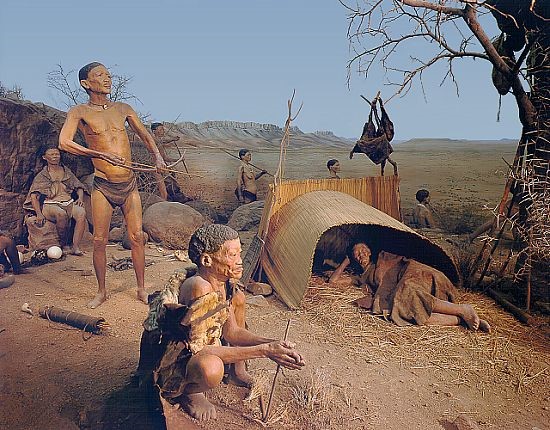
The museum began as an archive of all that Europeans found different, savage and curious in the world. Museums were institutions of categorization and exclusion that placed Eurocentric ideals on a pedestal of civilized modernity and progress. Beginning not long before but expanding after the dismantling of the apartheid in South Africa indigenous groups from all around the globe began speaking out against the bias of museums and demanding the return of human remains spurred the evolution of what a museum was.
After the apartheid in South Africa was abolished in 1994 the new democratic government deemed the reconstruction of South African history vital to the revival of the diverse cultural groups that had been suppressed during the apartheid. The process of rewriting the exclusionary history cultivated by the bias views of the apartheid supporters also meant that the reconstruction of anthropological education was a necessity. This task meant new curriculums for the education of South Africans; the dismantling of the biased history already in place, including the “Bushman” diorama and finally correcting the vile maltreatment of South African remains in academic institutions and museums both nationally and internationally.
For South Africa to be able to show the world what it meant to be South African from a historical and anthropological sense, the newly democratic country had to be able to meet the international academic community on equal footing. This was a monumental task, especially when much of what the world saw as South African cultural history was tinted by the bias representations provided by colonialism, Eurocentric criticism and scientific racism. These interpretations had stripped South African remains of their humanity and depicted them as sub-human or animalistic savages. To combat this incorrect representation the South African government rewrote history, removing the false information with new curriculums that contained information about the rich and varied cultural histories of the peoples of South Africa. The goal was to instill “pride in African history and identity”. The target audience for the new programs and curriculums was “primary and secondary school students, strengthening the image of these initiatives as re-writing history from the bottom up”.

The “Bushman” diorama (figure 1) displayed in the Iziko South African Museum made by Margaret Shaw in 1959-1960 out of resin casts (created by James Drury) depicted the Khoisan of South Africa as savage hunter gathers, similar to depictions of prehistoric early humans. They were shown as being part of an obsolete world that had no chance at surviving in the “civilized” modern world. This view of the Khoisan peoples contributed to the colonial view that the peoples of South Africa were of a lesser status that those of European decent and reinforced the apartheid opinion that South African groups needed to be controlled by the Caucasian minority while being kept separate from other racial populations. To remedy this damning representation the South African government took the diorama, which had been on display “for over 40 years” and closed it in 2001. The Iziko Council debated what to do with the offensive diorama. In 2011 the council deemed the resin casts as “unethically collected human remains” the casts were removed from the diorama and replaced with wire figures. The diorama was reopened to the public in 2013 having been altered to show a more respectful and accurate representation of the Khoisan people.
The greatest change made to South African museum practices was their view and treatment of South African human remains. Instead of allowing the remains to continue on as nameless specimens that represented blanket interpretations of cultural groups the South African government strove to give the remains their humanity back. Allowing them to be see as individuals deserving of respect and their basic human rights. As individuals the remains deserved to be treated with dignity and their cultural traditions acknowledged and respected, including funeral practices. Quoting Jacob Zuma, Ciraj Rassool in Re-storing the Skeletons of Empire: Return, Reburial and Rehumanisation in Southern Africa stated that when the remains’ human status was acknowledged it
“turned them not only into humans, but also into subjects of history. Their dead bodies, transformed from objects of race to those of subjects of history through cultural ceremony and political ritual, becoming significant to the nation”.
Rassool also quoted Zuma saying that
“no museum ‘must have a collection or material that depicts any section of the South African population as colonial objects”.
The desire to see South African remains housed in museums and educational institutions did not end at the borders of South Africa. The country joined an international effort to see all remains treated with the respect that their cultural groups demanded.
The case with Sarah Baartman was a perfect example. She was a Khoi Khoi woman who was on display at the Musee de L’homme after her death in 1816 until her return and internment in South Africa August 9th, 2002. During her life she suffered inexcusable hardships and abuse. She was taken in an attack during her wedding ceremony and she ended up working as a slave for the farmer Peter Cezar. She was then contracted by his brother Hendric Cezar to go to Europe and preform as the Hottentot Venus. Once in England she was subjected to grueling workloads and treated as an object of curiosity and sick fascination. Due to her large buttocks, she differed from the European ideal and this made her less than human in their eyes. Naturalists were fascinated by her genitalia and disregarded any sense of decorum or respect when regarding her. After she was moved to France and sold to Reaux, an animal trainer, she died at the age of twenty-six. Her body was further abused when it was given to the Museum of Natural History; a cast was made of her corpse, her reproductive organs were removed along with her brain, preserved in jars and finally her skeleton was de-fleshed and prepared for display. After close to 200 years after her death the South African government successful in gaining the return of Sarah Baartman’s remains. The French government passed a case-specific decision to release her remains for internment. She was shipped back it South African to be buried with the respect she was deprived of during her short life. The Hottentot Venus finally put to rest, not as a curiosity, not as a slave, but as a woman.
The changes to policy regarding the ownership of human remains created the opportunity for countries, like South Africa, to reclaim its people and give them back their dignity. This opportunity also created new problems for the museums and academic institutions which housed human remains, both ancient and modern. The reclaiming of remains created the worry that in returning the remains information could be lost regarding the evolution and structure of their specific lives and cultural groups. Once the remains were returned, they were expected to be subsequently interned, whether through simply burial or cremation. Requirements needed to be put in place to determine which individuals’ countries could reclaim and how countries and cultural groups could go about reclaiming their remains without hindering the research of archaeological and anthropological groups.
¹Rachel King, “Teaching Archaeological Pasts in South Africa: Historical and Contemporary Considerations of Archaeological Education,” Archaeologies: Journal of the World Archaeological Congress 8, no. 2 (September 12, 2012): p. 85, accessed December 21, 2016, doi:10.1007/s11759-012-9202-3.
²Rachel King, “Teaching Archaeological Pasts in South Africa,” p. 11.
³Rachel King, “Teaching Archaeological Pasts in South Africa,” p. 3.
4.Elizabeth Rankin, “Creating/Curating Cultural Capital: Monuments and Museums for Post-Apartheid South Africa,” Humanities 2, no. 1 (March 21, 2013): p. 80, doi:10.3390/h2010072.
5.Ciraj Rassool, “Re-storing the Skeletons of Empire: Return, Reburial and Rehumanisation in Southern Africa,” Journal of Southern African Studies 41, no. 3 (May 27, 2015): p. 12- 13, doi:10.1080/03057070.2015.1028002.
6.Ciraj Rassool, “Re-storing the Skeletons of Empire,” p. 12-17.
7.Ciraj Rassool, “Re-storing the Skeletons of Empire,” p. 12-17.
8.Ciraj Rassool, “Re-storing the Skeletons of Empire,” p. 17.
9.Ciraj Rassool, “Re-storing the Skeletons of Empire,” p. 29.
10.Ciraj Rassool, “Re-storing the Skeletons of Empire,” p. 28.
11.Chris Denton, “Sara Baartman and the Ethics of Representation,” Research in African Literatures 46, no. 2 (2015): p. 43, doi:10.2979/reseafrilite.46.2.32.
12.The Life and Times of Sarah Baartman The Hottentot Venus, dir. Zola Maseko (United States of America : First Run / Icarus Films, 1998), DVD, 5 minutes 16 seconds.
13.The Life and Times of Sarah Baartman The Hottentot Venus, dir. Zola Maseko, 10 minutes 16 seconds.
14.The Life and Times of Sarah Baartman The Hottentot Venus, dir. Zola Maseko, 29 minutes 41 seconds.
15.Chris Dunton, “Sara Baartman and the Ethics of Representation,” p. 2.
16.Chris Dunton, “Sara Baartman and the Ethics of Representation,” p. 2.
17.Chris Dunton, “Sara Baartman and the Ethics of Representation,” p. 1-2.











